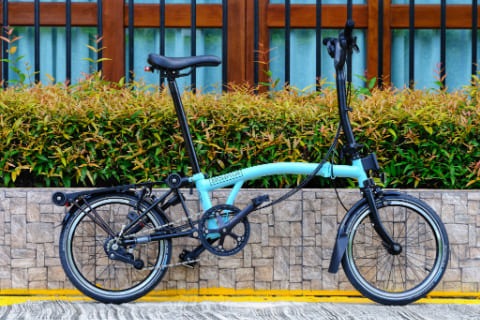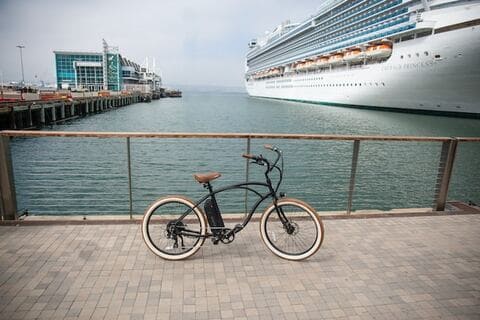One of the main appeals of foldable bikes is their compact nature and portability. This makes the weight of the bike critical. Ideally, it will be light enough to carry in one hand. So, how much does a folding bike weigh?
On average, folding bikes will weigh between 20 to 30 pounds. Numerous factors, like the frame, wheel size, and electric motor, can significantly impact how much the bike weighs. Generally, folding bikes can carry between 220 to 240 pounds.

Estimating a foldable bike’s weight can be a little tricky. Each cycle will be unique. Keep reading to learn more about how much you can expect a folding bike to weigh.
What Is A Typical Folding Bike Weight?
Most foldable bikes will weigh between 20 to 30 pounds. Though there is a large amount of variation in this measurement. For example, some manufacturers can produce a folding bike that weighs 15 pounds. On the other hand, the Vika+ will weigh 50 pounds.

Most folding bikes will weigh between 20 to 30 pounds (9 to 13.6 kilograms). For example, here are some of the most popular bikes and how much they weigh:
- Brompton Superlight. This bike is the lightest in the Brompton range. Because of this, it will weigh just 20.7 pounds (9.3 kilograms).
- Bike Friday pakiT. This model will weigh 22.5 pounds and, once folded, can fit into a backpack.
- Hummingbird Flex. The Hummingbird Flex is one of the lightest folding bikes in the world. It weighs 15.4 pounds (7 kilograms). It can achieve this low weight by having a frame made from flax plant fibers.
- Dahon Mariner D8. This is more typical of the weight you can expect from a regular folding bike. Its weight is 27.6 pounds (12.56 kg).
- Vika+. The Vika+ weighs approximately 50 pounds, making it one of the heaviest folding bikes in the world. This is primarily because of the use of electrical motors.
Before you purchase a prospective folding bike, it’s a good idea to check the model’s weight. The bike’s weight should be listed in the product specifications on the manufacturer’s website.
How Do Folding Bike Weights Compare To Conventional Bikes?
Folding bikes are often highly prized because of how compact they are. To understand how much a folding bike weighs, we can look at how they compare to other types of bikes. The following are generalizations:
- Road bikes. These are often lightweight, making them better for longer rides. They will weigh between 20 to 25 pounds.
- Touring bikes. Touring bikes tend to be a little heavier because they come with storage. They might also have electric motors, which can be helpful on longer journeys. Because of this, they will weigh between 26 to 33 pounds.
- Mountain bikes. These are known for their strong frames, which can cope with harsh off-road conditions. But this can increase the weight. On average, mountain bikes will weigh 29 pounds.
What Affects The Weight Of A Folding Bike?
Whether the bike has an electric battery, frame materials, and the size of the wheels can all play an essential role in determining bike weight. Though the brand can also hold a critical role, manufacturers like Hummingbird focus on how much their bikes weigh.
How much a bike weighs can vary, depending on the folding bike brand and model you choose. With this in mind, let’s look at some of the elements that have the most significant impact on bike weight:

- Electrical batteries. Typically, folding bikes that have an electric motor will weigh more than those that don’t. Of course, though, some bikes have low weight and electric batteries. But this is a rare combination that usually necessitates a high cost.
- Frame. The materials used to make the bike frame will be critical. Some are both strong and lightweight, like carbon fiber. Steel and aluminum, while strong, will be a little heavier.
- Size of the tires. Usually, folding bike tires will come in a few sizes. The smallest is usually 14 inches, and the largest can be up to 25 inches. Though most will be between 16 to 24 inches. The bigger the bike tire, the heavier the bike will be.
- The number of gears. The more gears, the heavier the folding bike will be. Though a wide range of gears will prove helpful if you live in a hilly location.
- Accessories. Sometimes, a folding bike might come with carriers or mudflaps. These features will improve the functionality of the cycle. However, they will also make it weigh slightly more.
It should be noted that there can also be a slight variation between the brands, depending on the manufacturer’s focus.
For example, a brand like Brompton will try to provide the best riding experience. As a result, they might add a few pounds to create more comfortable seating or a better gear system.
On the other hand, a brand like Hummingbird focuses more on creating the lightest folding bikes on the market. Even their electric bike weighs just 22.5 pounds (10.7 kilograms).
Folding Bike Weight Limit: How Much Can They Carry?
A folding bike can usually hold between 220 to 240 pounds. Too much weight can damage the frame. Cracks, unusual tones, and scratches are all signs of damage. Cyclists are urged to avoid riding if they are concerned about the safety of their frame.
How much weight you can place onto a folding bike can vary. It will often depend on the frame material, which determines the amount of stress it will be able to withstand.
The type of bike will also affect the weight limit. For example, cargo bikes will typically be able to hold more than commuter bikes.

Most folding bikes will have a weight limit of between 220 to 240 pounds (100 to 110 kilograms). The exact amount of the weight limit can be found in the product specifications.
You mustn’t exceed this limit. If you do, you will be placing excess pressure on the frame. There are a few signs that this is occurring, including:
- Cracks. These will most commonly appear around the bike’s hinges; because of how strong the frames are, even a tiny crack can signify substantial damage.
- Odd sound. Some frame materials, like carbon, have a distinct sound. If they become damaged, the tone will change completely.
- Scratch. A small scratch might not be a sign that anything is wrong. They are a normal part of bike wear and tear. But they might be a warning sign if they occur around vulnerable areas, like the hinges.
If you are concerned about the frame’s integrity, you shouldn’t ride the bike.
It’s best to go to your local bike store. They will be able to examine the frame in more detail and decide if its integrity is still intact.
There will also be weight limits on other parts of your bike. For example, if you have baskets or rear racks, you’ll need to know how much they can hold. The metal can get cracked or bent out of shape if you overload them.
Final Thoughts
The best folding bikes tend to be reasonably lightweight. At under 30 pounds, you should be able to lift them easily with one hand. The low weight will provide more versatility, allowing owners to take these bikes on trains and buses without causing any hassles.


![Best Lightweight Folding Bike [Year] (8 Lightest Foldables)](https://www.foldingbikeguy.com/wp-content/uploads/Best-Lightweight-Folding-Bike.jpg)



